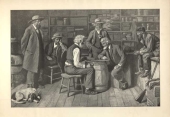The Checker Maven
The World's Most Widely Read Checkers and Draughts Publication
Bob Newell, Editor-in-Chief
Published each Saturday morning in Honolulu, Hawai`i
Contests in Progress:
Hidden Beauty on a Draughtsboard
Our article title is the subtitle of Melvyn Green's Stroke Problems, a large and grand collection of original compositions by the Salford, England master of the art. Mr. Green has very kindly given us permission to publish one of what he terms the "easier" situations from his book.
BLACK
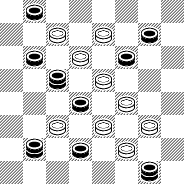
WHITE
White to Move and Win
Oh, the solution? Click on Read More.... but only if you must!
[Read More]Richard Pask's Supplement to Oldbury's Move Over
Grandmaster Richard Pask has completed his supplement to Derek E. Oldbury's classic Move Over, and has very kindly allowed us to offer it here for download.

Be sure to read Mr. Pask's latest work, which is as much a fine tribute to a great player as it is a superb elucidation of a classic text.
Note: the download at the moment is in "Word" format, meant to be printed on A4 paper, and requiring Jim Loy's checker font to render the title page illustration correctly.
Masterpiece
Here is an elegant problem by an unknown author, as originally published by Tom Wiswell. It is not easy but is worth the effort.
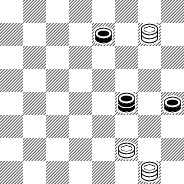
WHITE
White to Play and Win
What, indeed, makes a problem a true masterpiece? Is it an elegant solution, a deep or hidden theme, a surprise ending, or other factors? We'll combine today's problem with this short survey asking what you like most in a checker problem.
[Read More]How Times Have Changed
The Checker Maven has reported on the exciting U.S. vs. Great Britain match being played on It's Your Turn at this very moment (April 2005). It's Your Turn is a correspondence style site; players take turns making their moves, just as you would do if you were truly playing by mail.

Correspondence Match, G. B. vs. U. S.
The following is the score between an English team captained by D. Bryant, and an American team lead by Ray Kemmerer. It will be noted that some of the players have "crossed the bar" since starting the match a few years ago.
Great Britain --- U. S. A.
R. J. Allen 0; A. J. Schmutz 0 drawn 4
D. Bryant 1; A. R. Dosset 2; drawn 1
W. Dixon 0; A. J. Lemense 0; drawn 4
C. Probert 0; W. E. Steere 0; drawn 4
J. Hawks 0; H. D. Kaufman 0; drawn 4
D. Exeter 0; A. Jensen 0; drawn 4
C. McKean 0; F. E. Potts 1; drawn 3
F. F. Smith 1; J. Tonkin 0; drawn 3
Total -- America 3, Great Britain 2, drawn 27. The heat between J. M. Roberts and J. L. Westenberger is not reported as yet.
Times have truly changed. The mind boggles at the prospect of a multi-game correspondence match, played via mail delivered back and forth across the Atlantic by ship. Small wonder the match went on for years and that some players indeed "crossed the bar" during this time.
Today's match is being played in "internet" time and all should be over in weeks, not years. And we certainly hope that no one "crosses the bar"!
The same issue of The Morris Systems Checkerist is full of articles about the 2nd live U. S. - G. B. match, which was in preparation at the time. It makes for interesting reading, and, while today's internet match continues, we'll reprint a few of those old columns here over the next few weeks.
But for the moment, keep up with all of today's action, in internet time, at the official tournament site.
Yet Two More Easy Pieces

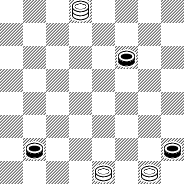
White to Play and Win
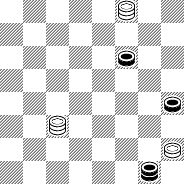
White to Play and Win
Solve the problems and check your solutions by clicking on Read More.
[Read More]WCC Platinum Programs/Cake Manchester Databases Soon To Be Available
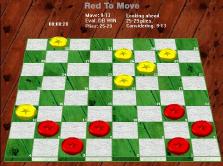
PLEASE NOTE: The download links and CD offers in this article are obsolete and no longer valid. As of October 2021, you can get Martin Fierz's programs and databases from his website. You can get WCC Platinum from archive.org.
Gil Dodgen's WCC Platinum II and III checker playing computer programs are now available for the cost of duplication and shipping. Testing was a complete success and we are ready to take orders. Please read our special web page for further information, prior to contacting us.

Please note: The Checker Maven maintains strict neutrality and impartiality. Our distribution of checker software and databases is intended as a service to the checker playing public, and must not be construed as making any kind of statement as to the claims or relative merits of any particular program or database. Such statements are made by us only in the context of a published review or evaluation.
Speeding Into Spring
Spring is here, it's April, and time for our more-or-less monthly selection of speed problems. Remember, the clock is running. How fast are you?

No. 2 (easy to medium)
Click on Read More for the solutions.
[Read More]USA vs. Great Britian Internet Challenge


But, very recently on the time scale of a full century, the internet has come on the scene and has offered all sorts of opportunities for checker play, of every type and quality (see our site reviews for a rundown on this). Last year, a team match called USA vs. the World was played out at the It's Your Turn play site (the games are documented and annotated at Jim Loy's web site). The teams were ad hoc and the level of play varied widely, but it was a great match overall.
Now, the historic US-Great Britain rivalry is about to be taken up on the internet, and for this matchup, the teams are staffed with top notch, championship grade players. The US team, captained by Yunior Lopez, will have in its lineup stars such as world champion Alex Moiseyev and living legend Richard Fortman. Not to be outdone, the British team, captained by Lindus Edwards, will field players of the caliber of mail-play champion George Miller, and special guest Jan Mortimer, who this fall will challenge Patricia Breen for the women's world championship.
The match begins at the It's Your Turn site on April 4. The games will be 3-move restriction and played postal-style with three days allowed for a move. Complete details can be found at the official web site for the match, and you can follow the results there as they come in.
This promises to be a history making, not-to-be-missed match. Put a few tall ones in the refrigerator and tune in at the official web site!
Wednesday is 'Anything Can Happen Day'

Now, on to this week's Wednesday problem. Originally published over 80 years ago, it was billed as a beginner's problem. And it's surely a case of "anything can happen" in that there were flaws in the original setting, clever though it was, and so we've made a few changes.
We start with this position, as originally published:
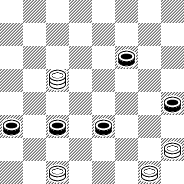
White to Play and Draw
But in the diagram above, what is the move that comes to mind at once, and that a beginner in particular would likely choose? It's 14-18, attacking two Black men at once. Yet this move loses! Here's the position, and the challenge for you:
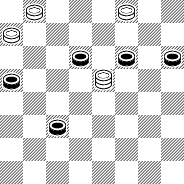
BLACK
Black to Play and Win
Did you get it? Click on Read More for the solution, and decide for yourself, though this is a situation a beginner might encounter, if this is truly a beginner's problem.
By the way, you get bonus points if you can recall where the idea of Wednesday being "Anything Can Happen Day" originally came from.
[Read More]The 'Fun Shot' in the Single Corner Opening
The Auditorium at Detroit's Public School 1115 was packed with kids of all shapes and sizes. They were all here to listen to their hero, Marvin J. Mavin, the Captain of the Detroit Doublejumpers and a star professional checker player in the National Checker League. Marvin was making one of his many school visits to promote the sport of checkers among our youth. And at P.S. 1115, he had come to the right place, as this school fielded several very strong teams in the Central Detroit Grade School Checker Federation.

Students at PS 1115 greet Marvin J. Mavin
"Hi there boys and girls!" he intoned in his deep baritone voice. Or maybe it wasn't all that deep. "Today we're going to talk about a really special checker opening line."
A few expressions of "yeah, right" seemed to float up from the back of the auditorium. But Marvin continued without a pause.
"I'm sure your coach has taught all of you to play 11-15 as your first move with Red, because it's a strong play toward the center and is considered to be Red's best starting move."
A chorus of "tell us something we don't know, Marvin" seemed to emanate from the left side of the main aisle.
"Now, as White, a reply often made to this is 22-18.."
"Yeah Marvin, the Single Corner, OK?" was called out by a student near the front.
"Very good, yes, Single Corner, I was sure you knew that!" Marvin replied. "But how many of you know the best continuations from this point?"
"Whaddya think, we're stoopit?" was heard from another student off to the left. But Marvin simply continued with his talk.
"If Red plays 11-15 - hey, that's your school name!" Marvin said, grinning, as the audience groaned some more, "and then after 22-18 the captures follow with 15-22, 25-18..."
"Duh, Marvin, they trade checkers, like we didn't know that!" piped up a boy somewhere in the middle of the auditorium.
Marvin swallowed, paused, and went on. "So now if Red plays 12-16, and White goes 29-25, then if Red tries 10-14...."
"Aww what kinda move is dat! Da coach 'ud trow me offa da team iffn I did sumthin' like dat!" interrupted another student in a strident voice.
Was Marvin actually turning just a tiny bit red? He cleared his throat lightly and carried on nonetheless. "Yes, I know 9-13 is popular here, but there's a special line in this opening that isn't seen very often. It's called "The Fun Shot" and I wonder if any of you have ever heard of it?"
The audience had become suddenly silent. Evidently Marvin had taken them into new territory.
"I didn't think so!" Marvin said triumphantly, and was that a slight smirk on his face? He quickly changed his expression to a neutral one. "The Fun Shot was given that name by Farmacio Fotocopia, a former player with the St. Louis Switchers, who analyzed it ..."
The audience was stirring again; they were quite young, after all. "That old guy!" one of them called, "he musta played fifty years ago!"
Marvin set his jaw tightly. "Well, then, who can show me the Fun Shot? Can you?" he said, pointing to the last interruptor.
The fifth grader squirmed in his seat and didn't reply.
"OK then, pay attention," Marvin continued, and went over to the huge demo board at the center of the stage. "Now, here's how it goes."
Marvin moved the large wooden pieces rapidly from peg to peg on the demo board, playing out these moves:
1. 11-15 22-18 2. 15x22 25x18 3. 12-16 29-25 4. 10-14 24-19
When he was done, the board showed the following position:
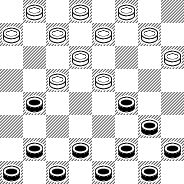
BLACK
Black to Move
"Here's where Red can take what amounts to a four-for-four shot," said Marvin, and made the following moves:
5. 7-10 19x12 6. 3-7 12x3 7. 14-17 21x14 8. 10x17 3x10 9. 6x29
Now the board looked like this:
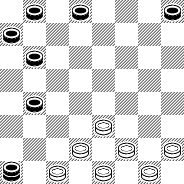
WHITE
White to Move - and Win?
Slowly the audience began to react. There were the sounds of seats shifting and feat scuffling. Finally, one student stood up, raised his arm and said, "Geez Marvin nobody'd ever play that one! Wassamattawhitcha anyhoo, showin' us dumb stuff like that! You been drinkin' too much a that beer a yours!"
This time, Marvin definitely turned red. "Well," he said. "Well, well, well."
Another kid piped up, "Hey that's a deep one Marvin, ha ha ha!"
Marvin paused at length, and finally seemed to become a bit more composed. He continued, "This is in fact thought to be a win for White, which is why this shot is seldom seen." Marvin grinned. Was that an evil grin on Marvin's face? "Perhaps, young man," he said in an even tone, "you would like to take the Whites, while I play the Reds, and you can show me just how smart you really are by demonstrating the win."
There were hoots from the crowd, followed by cheers and applause, and cries of, "C'mon Billie, take 'em on! Show 'em yer stuff!" Then amidst nearly thunderous noise and commotion, the heckler stood up, ruffled his hair, tugged on his shirt and jeans, and started toward the front of the auditorium.
"Go Billie! Go Billie! Go Billie go!" the crowd chanted, over and over, louder and louder, until Billie arrived at the demonstration board on the stage. He grinned a little, looked back at the audience, then turned to the board and played......
Well, dear reader, just what did Billie play? Was the sassy fourth grader able to win this position against a top pro such as Marvin J. Mavin? Can you win this position?
To be continued.....
The Checker Maven is produced at editorial offices in Honolulu, Hawai`i, as a completely non-commercial public service from which no profit is obtained or sought. Original material is Copyright © 2004-2025 Avi Gobbler Publishing. Other material is the property of the respective owners. Information presented on this site is offered as-is, at no cost, and bears no express or implied warranty as to accuracy or usability. You agree that you use such information entirely at your own risk. No liabilities of any kind under any legal theory whatsoever are accepted. The Checker Maven is dedicated to the memory of Mr. Bob Newell, Sr.

